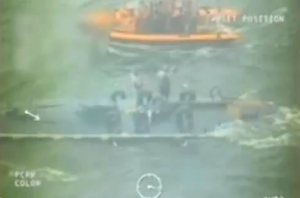First Caribbean drug sub bust
Posted by LT Connie Braesch, Tuesday, August 9, 2011
UPDATE: Paragraph three was updated to include Customs and Border Protection’s contributions to the drug interdiction operation, and paragraph five was updated to clarify the SPSS was the first Caribbean interdiction by the U.S. Coast Guard.

Crewmembers from the Coast Guard Cutter Oak, homeported in Charleston, S.C., offload 15,000 pounds of cocaine worth more than $180 million at the Coast Guard Base Support Unit Miami, Aug. 2, 2011. U.S. Coast Guard photo by Petty Officer 3rd Class Tara Molle.
As America’s lead maritime law enforcement agency, the Coast Guard is a key player in preventing transnational threats from reaching the United States. This includes stopping large quantities of drugs from reaching the shorelines and spreading out across our nation. From the smuggling of opium on merchant ships by Chinese immigrants in 1870 to the bootlegging of alcohol during the Prohibition era, the Coast Guard has been on the scene curtailing maritime contraband smuggling and protecting American national interests on the seas.

A petty officer from the Oak stands guard while crewmembers offload cocaine seized from self-propelled, semi-submersible interdicted in the western Caribbean Sea. U.S. Coast Guard photo by Petty Officer 3rd Class Tara Molle.
Over the years the maritime transit of illegal contraband has grown in size, scope and sophistication. Infiltration methods across the maritime borders continue to evolve as drug traffickers explore new ways of avoiding detection.
A single, well-executed bust not only hurts drug trafficking organizations, but it can also provide valuable intelligence for future counter drug missions. Recently, the 270-foot Coast Guard Cutter Seneca, a Coast Guard C-130 aircraft and a Customs and Border Protection P-3 aircraft interdicted a self-propelled, semi-submersible, also known as an SPSS, vessel in the western Caribbean Sea seizing almost seven metric tons of cocaine worth approximately $180 million.
“Medium-endurance cutters like the Seneca are built for sustained offshore patrols including those that require enhanced communications, and helicopter and pursuit boat operations such as this. They provide a key capability for the nation’s homeland security operations at sea and allow us to fight the threats to our homeland security before they arrive at our doorstep,” said Rear Adm. William Baumgartner, commander of the Seventh Coast Guard District headquartered in Miami.

Click on this image to watch a video of the self-propelled, semi-submersible interdiction in the western Caribbean Sea on July 13, and the subsequent offload of 15,000 pounds of cocaine Aug. 2. U.S. Coast Guard video.
While several SPSS vessels have been interdicted in the Eastern Pacific since they began appearing in 2006, this is the first SPSS seizure in the Caribbean by the U.S. Coast Guard. This case was also the first time the Coast Guard used divers to recover contraband because shortly after the suspected drug traffickers were detained, the SPSS sank.
“SPSS crews typically abandon and scuttle the vessels along with the drugs and any evidence of their illicit activities when detected by law enforcement authorities,” said Lou Orsini, senior maritime law enforcement advisor, Coast Guard Office of Law Enforcement. “Prior to the passage of the Drug Vessel Trafficking Interdiction Act of 2008, this was a very effective means of avoiding prosecution for drug smuggling. However, this new law allowed for prosecution of suspected drug smugglers using these stealth vessels without having to risk officer safety to try to recover contraband from a sinking vessel. In this case, the relatively shallow depth in which the SPSS sank made it necessary for us to recover the drugs to prevent their recovery by the drug trafficking organization” Orsini added.

The interdiction of an SPSS was the first of its kind in the Western Caribbean and the first case where divers recovered contraband from then sunken SPSS. U.S. Coast Guard photo.
To locate the SPSS on the ocean floor, the Coast Guard Cutter Oak – a 225-foot seagoing buoy tender, used its side scanning sonar to search for the submerged vessel. It then deployed Federal Bureau of Investigation dive teams to remove the drugs.
“The SPSS interdiction in the Caribbean shows that these transnational criminal organizations respond quickly to new tactics, techniques and procedures employed by law enforcement with rapid, creative changes to their operations requiring the Coast Guard to be equally adaptive,” said Orsini. “Our ability to rapidly recognize new trends and identify solutions to fight our adversaries is paramount to our success.”
This interdiction and recovery operation highlights the mission capabilities of the Coast Guard’s assets and people. As maritime threats continue to evolve, the Coast Guard stands ready to respond – forward deploying surface and air assets, leveraging international and domestic partnerships and preparing for contingencies to protect our homeland.
Tags: cocaine, drug interdiction, drug sub, law enforcement, self-propelled, semi-submersible
-
s.stephens
-
Dave
-
Fr. Russ Carmichael
-
Coastie1780
-
BRIG
-
CWO3 Randy Litka
-
CrossFit1
-
Ruisanchez
-
LT Connie Braesch
-
Tim Hecht
-
LT Patrick Montgomery
-
Ken Andersen
-
CAPT Al Arsenault
-
D.Varela
-
BM2 Waller
-
Mean Green
-
John
-
SA RIVER
-
T. Augustine Lo
-
MITCH
-
tom











